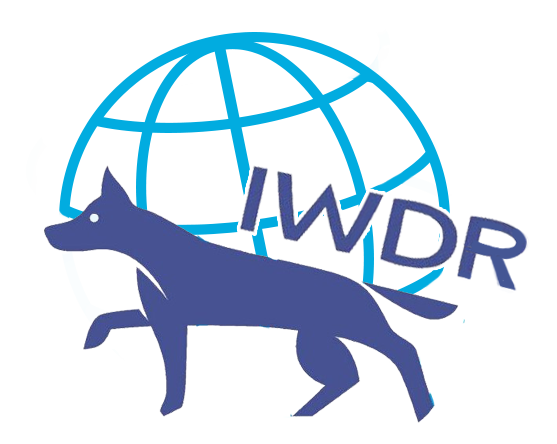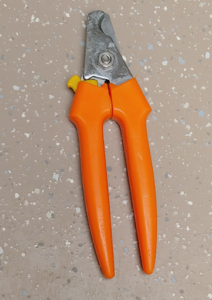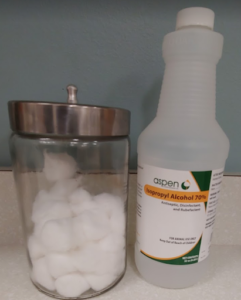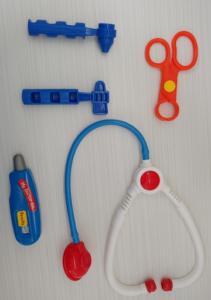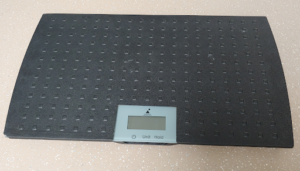Early Socialization - Week 7 - 42-49 Days
![]() TIP: Click the quick-links above to go directly to each section. You can also click the anchor icons at each section to return to the top of the page.
TIP: Click the quick-links above to go directly to each section. You can also click the anchor icons at each section to return to the top of the page.
Quick Reference Guide:
Goal:
At 7 weeks old, puppies are well into their critical socialization period and have fully developed visual, auditory, and olfactory senses. Emphasize variety of novel object and noise exposure, start one on one relationship work.
Environments:
Passive environmental enrichment- Litter’s den, play area, or outdoor area with precautions in place- Click to view Biosecurity section. Interactive activities can be done in a separate clean room, litter’s play area.
Volunteer Type:
Active, with an active understanding of puppy body language and reinforcing positive behaviours and manipulating the environment to set pups up for success.
Introduction
Massive brain development continues this week. Milestones include near adult vision and an innate inquisitive about their environment. The motor skills are more advanced so the environment can include larger objects for pups to climb over, go through or stand on.
Enhanced proprioception ability enables pups to enjoy more advanced motion equipment. This is the time to offer a more enriched environment full of different visual, sound, movement, surfaces as well as a large variety of people of all ages. During this age group there is a huge potential to influence just how sound and confident the puppy will become as an adult.
Labrador Retrievers are in the middle their most influential critical period to be exposed to novelty and nearing the end for sounds and motor development. Increase variety and provide both passive and active opportunities being mindful to observe the emotional state and adjust as needed. German Shepherds most sensitive period for novelty is 4-7 weeks.
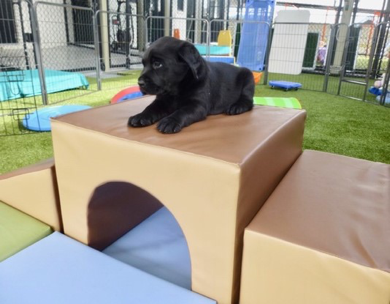
PUP readily shifts between the ENGAGED (GREEN ZONE) and THE CONFLICTED (YELLOW ZONE) when learning or exposed to something new.
- When alone or in groups in a familiar situation pup readily acclimates in a new environment and/or around novel objects, noise.
- Pups respond readily to being called, accept being handled for an exam or cradled on their back in your lap.
- Pups are adept at climbing on and around items that are no higher than one half of their leg length.
- Pups are socially polite around people. They do not bite hands, shoes or ankles.
- Pups accept being in a crate with another pup for up to 10 minutes.
- Variety of exposure is very important. Sights,sounds, objects, people, places while being mindful of biosecurity
- Pups still need large amounts of sleep. Do not over stimulate the pup. It cannot learn in this mode
- Observe pup and adjust procedure appropriately so it is a positive learning experience. Each pup is worked as an individual and techniques are for this pup not the whole litter.
- Early repeat exposure in different environments will add to pup’s confidence and ability to stay or return to a productive state
- Keep it brief: Remember pups have short attention spans. A successful exposure may be only seconds long and an entire education session should be no more than 5 minutes.
- Make adjustments to help the pup stay or return to a productive emotional state: Shifts in energy, ability to stay engaged with you, body language signs of stress are all indicators that the pup needs a break. Allow the pup to sort things out or just simply take time to relax.
During interactive activities, we continue to promote the puppy handler bond. Any time the pup choses to return its focus onto the handler reward this choice immediately with a smile, praise, and stroking. Giving food any time the pup connects to you will create pups only interested in food, so use it only as needed.
Mix up the rewards so puppy has variety and keeps interested and wanting to bond and work with us. Remember to use a reward that the puppy sees as reinforcing for it. Some Golden Retrievers are not as food oriented as say a Labrador Retriever. Should food not be a strong motivator try a soft fluffy toy or hard rubber toy. The pups focus should be on the handler so lots of rewards for good choices. The frequency of food rewards can become intermittent then phased out when the pup is older.
Remember that YOU are the reward for the pups and deepening your relationship and bond is enhanced by touch and interactions that are rewarding to the pup. Occasionally food is needed but think of it as icing on the cake. You need to build the foundation of your relationship first. This week is a great time for short periods of one on one time with each pup to develop skills needed when pups leave for their puppy raisers.
Provide both passive and active (interactive activities) to expose puppies to new objects, sounds, surfaces and movement in the environments and to enable us to get feedback about how the pup responds. The information we collect helps give us to continue to build up a better picture of the puppy’s personality and how they cope with changes in environment, how inquisitive and confident they are and overall whether the puppy would be a good candidate as a guide or service dog.
Continue to promote remaining calm relaxed during body handling and massage as the building up of positive human relationships continues this week.
Items needed for Den this week – Variety is important to keep pups inquisitive and accepting of change
Toilet Box (To be used if needed by pups in between toilet breaks)
Ramp to concrete
Sound
Visuals
Surfaces
Movement
Random Object
Hanging Toys
Activity Box
Hard Chew Toys
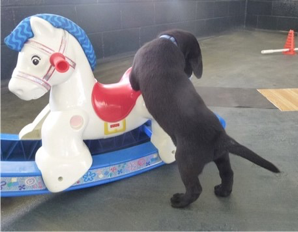
Problem Solving
- If the pup is struggling with body handling you may have progressed too fast, tried to do it for too long or the pup has had a negative experience previous to this session.
- After the pup has released any emotional energy and relaxed, reestablish a positive connection then briefly position the pup between your knees for the first step of body handling, Stroke the pup calmly for a few seconds, praise and release the pup.
- Repeat once more as above
- After giving the pup some time to play or explore, do another brief body handling exercise at the level of an earlier step where the pup is comfortable. Release the pup as soon as you feel the pup relaxing or accepting.
• Consider adding the marker word YES when the pup relaxes, release the pup and follow-up with a food reward and praise. - Over the day do no more than 1 minute of body handling 2 or 3 times. Progress only as the pup is relaxed.
- For pups that are very wiggly or stressed, proceed more slowly but do more successful very brief sessions in a day
If a puppy has a significant change in energy and/or needs a longer time to recover, give the puppy time to resolve the conflict on their own. The handler can give the puppy support and encouragement with voice and soft petting. If the puppy has a severe change in energy and is no longer able to be engaged with the handler and activity, end the session on a positive note and return the puppy to their litter.
- Allow pup time to resolve inner conflict themselves
- Offer emotional support via voice and touch
- Shorten duration of visit. If one pup displays distress signs (whining) the others will usually follow. Be prepared to move when all pups are quiet so as not to reinforce a negative behaviour (whining gets what I want)
- Engage with pup using favourite toy
- Have handler stand or sit near the area pups are concerned. Don’t coax but do stroke and interact happily with pups when they choose to come
- If an item is making noise, decrease the intensity
- Be certain pups have the freedom to move around in the area and choose to explore when comfortable
- Pair a less confident pup with a more confident sibling. If mom is available it is helpful to have her in the area as wel.
If the pups are overwhelmed and not acclimating, return them to their den with Mom and try a shorter amount of time or less intense situation next time.
Stop and place hands around pup’s chest area. Do some gentle circular motion with your hands. Once pup is calm again you can resume the body handling.
It can help to go back to an area on the body that pup is comfortable being handled and try again.
Should pup still not be comfortable reduce the session times then build up again.
Try luring with slower, more deliberate movements. Make sure you have pup’s interest in the lure and maintain that connection. Practice moving your arm with a “mixing bowl” movement – wide, sweeping and steady.
Consider introducing a “get a toy” command to encourage puppy to chew and mouth on an appropriate toy instead of your hands and arms! Introduce this by getting a soft toy and engaging in play. Each time pup takes the toy into it’s mouth say “get a toy” / “good puppy”.
Passive Environmental Enrichment
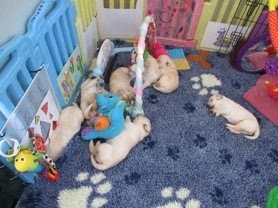
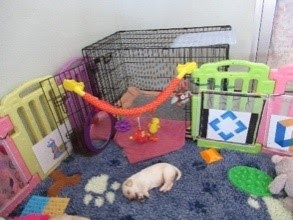
|
An example of a colorful object that puppies will not normally encounter in a kennel environment but may encounter one day. 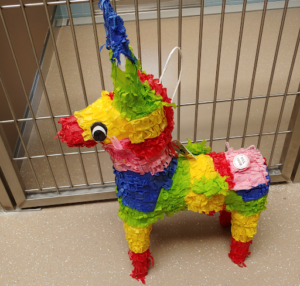
|
This mobile is brightly colored, plays soft music, and moves. This item encourages puppies to be aware of objects that are above them. 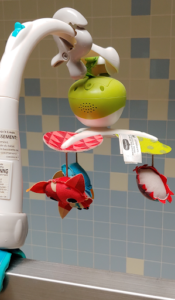
|
|
Waffle blocks are made of hard plastic and can be placed inside the kennel for passive environmental enrichment. The cube also breaks up the kennel which can help reduce rough play between puppies. 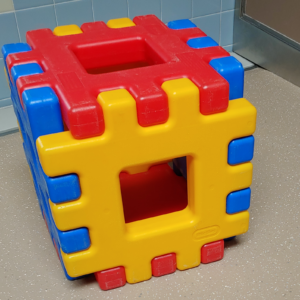
|
Continue to expose puppies to people wearing a variety of different items. A safety vest is an easy example of an item that can be worn by staff in the kennel without taking up additional time in their day. 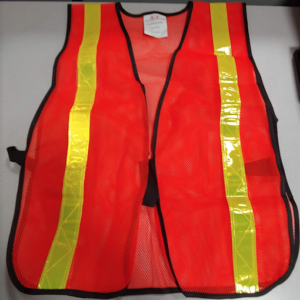
|
Note this video covers multiple age groups. Please see the section from 3:08 – 5:13 for content appropriate for this age group.
Working dogs encounter a variety of sounds throughout their career. Some dogs may travel with their partner through busy cities while others may go to the Opera or loud concerts with their partner. With all of the different sounds a dog may encounter, we want our puppies to be comfortable and confident with many different sounds during their critical socialization period. During this week, we will focus on positive interactions with different sounds.
Environmental sound CDs as well as music or talk back radio can be played. If there is an extra small metal crate a DVD player or computer laptop can be placed in the locked crate and a movie played. Lots of variety to keep pups interested.
Turn sounds on and off as well as changing the direction the sound is coming from. Our aim is to have the pups to be aware there was a change happening rather than then blocking out sounds that are playing continuously.
Continue to play passive unpredictable sounds for the puppies in their kennels or outside in their play area.
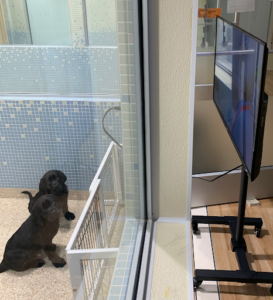
Hand-held sounds items as well as interactive sound objects can be used during this activity. Below are age-appropriate examples for both hand-held objects as well as other sound items that puppies can interact directly with.
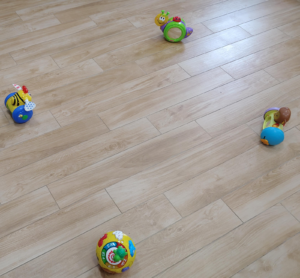
Goal: To allow puppies to explore multiple sound objects with a handler and to be comfortable with a variety of sounds.
To prepare the designated space for this curriculum, please complete the following steps.
- Gather 5 noise objects and 2 handheld noise objects. Remember variety when selecting objects.
- Place the handheld noise objects on a nearby counter or out of puppies’ reach.
- Arrange the objects in a circle spread apart enough for the puppies and handler to move around comfortably.
You are now ready to retrieve the litter of puppies you are working with.
- Allow the puppies to explore the room upon entering for up to 30 seconds.
- Use the hand-held noise objects when the puppies are playing and exploring the room.
- Encourage the puppies to explore each of the objects with you.
4. Continue around the circle in the same manner
Mobile Smart TV-
Passive exposure to TV or movies creates an unpredictable “real world” safe environment inside of the kennel. Below are examples of channels and movies and their benefits:
| Channel or Movie Examples | Benefits |
| Children cartoons | Variety of different character voices and unusual noises |
| Nature | Passive and controlled exposure to thunder, rain storms, birds chirping, water flowing, etc. |
| Musicals | Variety of singing, laughter, and noises |
| Disney Movies | Variety of singing, laughter, and noises |
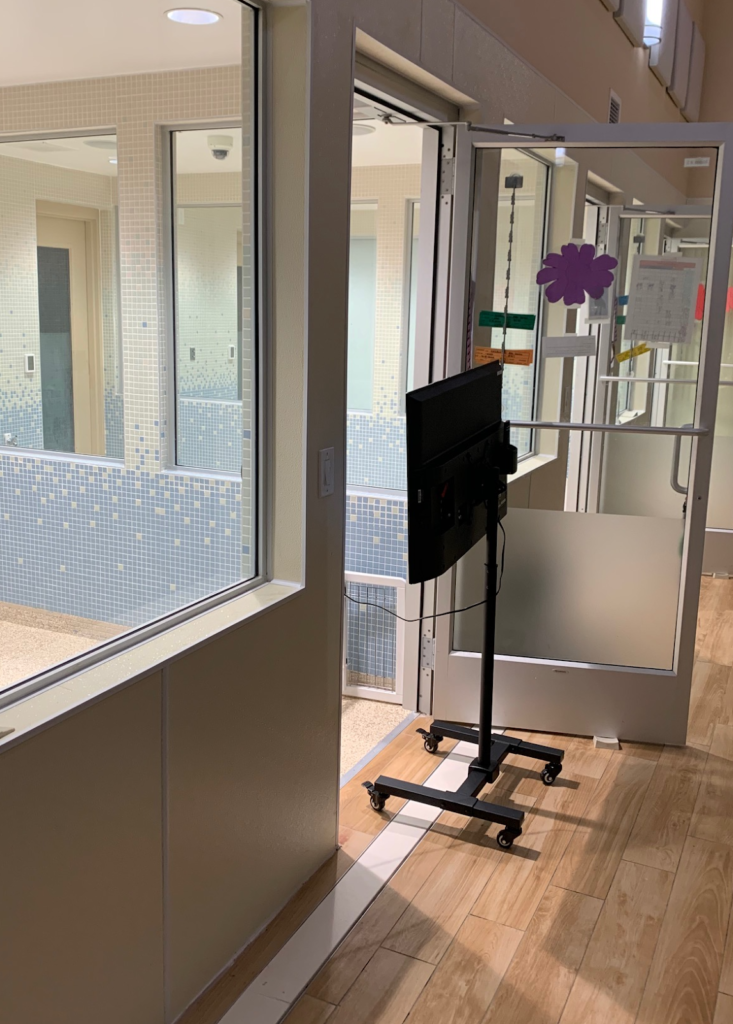
This TV is mounted on a mobile TV stand. The height of the stand can be adjusted for the age of the puppies.
Alert symbol Make sure that wires are out of the puppies’ reach when setting up.
Play TV at a low-medium volume level. Watch the puppies’ body language and turn down the volume or change to a different channel if puppies begin to show stress signs.
It is important for working dogs to be comfortable with walking over different types of surfaces such as grates and uneven pavements. Puppies learn quickly that walking over bumpy and open surfaces is completely normal.
It is important to have a variety of surfaces for the puppies to walk on so they do not grow accustomed to only walking over one particular surface. When selecting equipment, think of having different textures and materials.
Continue to build confidence on different surfaces and elevations in the puppies’ play area.
More challenging surfaces can be added in the litter’s room to encourage them to climb and walk over different surfaces. This helps build the puppy’s confidence and also their muscles! Keep in mind that the surfaces need to be age and skill appropriate.
Examples of age appropriate surfaces include:
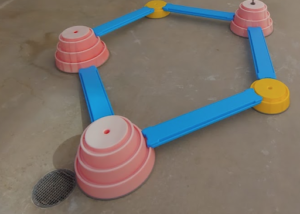
Elevated and Uneven surfaces: Builds confidence and increases limb strength

Goal: For the puppies to confidently explore each surface with a handler.
- Choose a variety of 5 surfaces. Items can be different heights, just be mindful of the puppy’s height, do not make it unsafe for the puppy.
- Arrange the items in a circle with enough distance for the puppies to walk comfortably around each item.
You are now ready to retrieve the litter of puppies you are working with.
- Allow the puppies to explore the room upon entering for up to 30 seconds.
- Encourage the puppies to climb on or walk over all of the surfaces.
3. Continue around the circle in the same manner.
Working dogs must be accepting of a variety of novel objects they may encounter in the community; so, it is important that at an early age they begin to build their reference library of unusual items, including those that move, so that they are comfortable and confident with different novel objects.
Working dogs must be accepting of a variety of novel objects they may encounter in the community; so, it is important that at an early age they begin to build their reference library of unusual items, including those that move, so that they are comfortable and confident with different novel objects.
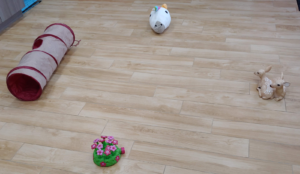
Novel Objects Protocol
Goal: To allow puppies to explore multiple novel objects with a handler and to be comfortable with novel objects.
To prepare your designated space for this activity, please complete the following steps.
- Gather 5 novel objects. Remember variety when selecting objects.
- Arrange the objects in a circle spread apart enough for the puppies and handler to move around comfortably.
You are now ready to retrieve the litter of puppies you are working with.
- Allow the puppies to explore the room upon entering for up to 30 seconds.
- Encourage the puppies to explore each of the objects with you.
- Continue around the circle in the same manner.
Safe items that move can be placed in the litter’s room to allow puppies to explore on their own.
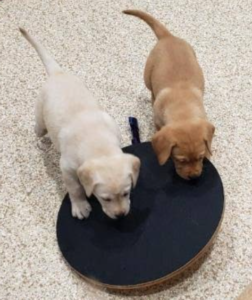
Working dogs need to be comfortable walking on unstable objects and comfortable with objects that move. It is important that puppies learn to be confident with walking on unstable objects and with moving objects.
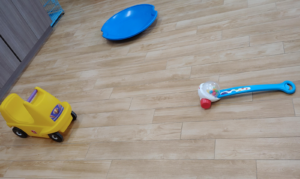
Goal: To allow puppies to explore multiple motion objects with a handler and to be comfortable with walking on unstable objects and moving objects.
To prepare the designated space for this activity, please complete the following steps.
- Gather 4-5 motion objects. Remember variety when selecting objects.
- Arrange the objects in a circle spread apart enough for the puppies and handler to move around comfortably.
You are now ready to retrieve the litter of puppies you are working with.
- Allow the puppies to explore the room upon entering for up to 30 seconds.
- Encourage the puppies to explore each of the objects with you.
- Continue around the circle in the same manner.
Ensure you introduce a large variety of new people, start gradually to build up pup’s acceptance of difference. Demographics to cover include; young, elderly, male, female, toddlers, different ethnic groups
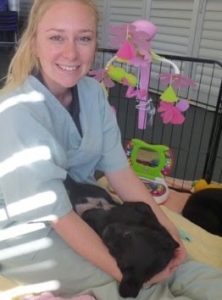
Passive open crate exposure is the foundation to crate training. Puppies can explore the crate and go in and out as they wish. Hard plastic crates can be used if the front door is taken off to prevent puppies from becoming stuck in the crate.
Also make sure that latch is fastened back if using a metal crate.
Soft bedding and interactive toys will help to promote positive associations around the crate.
You can review further information on crate settling here.
Also, make sure to consider Biosecurity if your crate is positioned around other dogs, or outside of the puppy pen, etc.
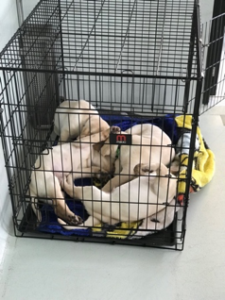
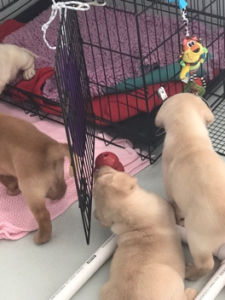
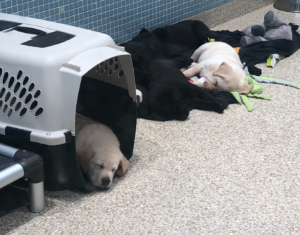
Puppies can now begin to get used to settling inside a closed crate. You can review further information on crate settling here.
Some tips:
- Soft bedding and interactive toys will help to promote positive associations around the crate. Make sure to supervise puppies with bedding in case they chew it. If the puppy chews bedding, remove it for the safety of the pup and make sure you provide appropriate chew toys while the pup is in the crate.
- Pup should spend time in a crate away from their littermates but around people. Puppies need to learn to settle in their crates while people are around, as this will prepare them for crate time in their raiser’s home.
- Offer the pup a stuffed Kong or nylabone.
- Start off slowly to build positive associations: gradually increase time in crate from 5 min to 30 mins. Make sure to toilet the pup before and after.
Interactive Activities
- Purposeful play with littermates exploring novel objects, sound objects, motion objects, and surfaces
- Puppies will develop positive experiences with body handling
- Puppies build positive associations with new objects and sounds
- Puppies build handler engagement
experiences around body handling, and puppies can build positive association with new objects and sounds. Every interaction with the puppies continues the building of handler engagement.
It is important to start to build a solid foundation of skills. Body Handing is ongoing and involves lots of practice. It can be done in short sessions throughout the day in order to set the pup up for success by keeping skill training fun and expectations consistent. Body handling is the process of teaching our puppies to accept all parts of their body being handled while remaining calm while we touch and move all parts of their body.
This is beneficial for health/Vet visits. These skills also help with body sensitivities to equipment the pup may need to wear such as boots or coat.
Remember, Body handling should be a calm, gentle process – it’s not a time for cuddles or play – that can come later! Take extra care around your pup’s teeth, ears and paws – these areas are crucial for Body Handling but many pups find the handling of these areas strange at first.
Start by Teaching the “Close” position:
- Start by crouching on the ground with the puppy in front of you, facing you.
- Place your right knee on the ground – If pup is on a lead put the lead under your knee so both hands are free 3. Use your left hand to lure the pup from your right knee in a circle until they are between your legs facing away from you
- Tilt your lure back over the pup’s head so they go into a sit
- Mark and pay
- Put your knee down so you are kneeling with pup sitting between your legs and place your two hands on the pup’s chest
- Repeat steps 1-6 until pup is quickly and easily moving into position as you lure
- Repeat steps 1-6 but this time say the word “close” just as their bottom touches the ground Do this 3 times 9. Fade the lure and work on duration – Reward pup for being still and calm. Ignore any wriggling or mouthing.
- Do this 3 times
- Fade the lure and work on duration – Reward pup for being still and calm. Ignore any wriggling or mouthing.
Handling Method
NOTE: For pups over 3 weeks, all handling starts in the “Close” position.
Ears
- Gently hold the puppy’s chin with one hand then use the other hand to lift their ear
- Look inside and smell their ear for any signs of infection
- Repeat with the other ear
- Gentle praise, reward
Eyes
- Hold puppy’s chin gently and look at each eye
- Gentle praise, reward
Teeth
- Gently hold pup’s chin and use the other hand to lift pup’s chin on one side to look at their teeth
- Repeat on the other side
- Gentle praise, reward
Legs and paws
- Run your hand down one of pup’s legs to their paw
- Feel between the pads on their paw
- Gentle praise, reward
- Repeat with other 3 paws
Vet Restraint
- Use your left hand to gently restrain pup’s head against your chest so they are looking towards your left
- Run your right hand down the back of the pup’s right leg to their elbow then raise their leg (it should be outstretched as if for a blood draw)
- Mark and pay
- Switch so pup is facing the opposite way and the other leg is outstretched
- Gentle praise, reward
Lay Over
- Place one arm underneath pup’s front legs
- Lift your arm (therefore lifting the pup’s front legs)
- Lean down until you are lying over the top of the dog
- Remove your hand from under the pup
- Gentle praise, reward
Release cue
- Tell the puppy “Go free” and allow them to break position
- Give them a pat and plenty of praise
Teach the “Close” position
- Start by crouching on the ground with the puppy in front of you, facing you.
- Place your right knee on the ground – If pup is on a lead put the lead under your knee so both hands are free 3. Use your left hand to lure the pup from your right knee in a circle until they are between your legs facing away from you
- Tilt your lure back over the pup’s head so they go into a sit
- Mark and pay
- Put your knee down so you are kneeling with pup sitting between your legs and place your two hands on the pup’s chest
- Repeat steps 1-6 until pup is quickly and easily moving into position as you lure
- Repeat steps 1-6 but this time say the word “close” just as they’re bottom touches the ground Do this 3 times 9. Fade the lure and work on duration – Reward pup for being still and calm. Ignore any wriggling or mouthing.
At 8 weeks old, puppies receive their first vaccines amongst many others that they will receive during their lives. Spending some time beforehand and allowing puppies to become familiar with equipment and procedures that veterinarians will use during their appointment will help prepare puppies for their first vaccines.
Equipment
Nail trimmers
| Cotton swabs soaked in alcohol
| Ballpoint pen
|
Children’s doctor set
| Scale
|
Procedure
Remember to take each step slowly and at the puppy’s pace. If the puppy begins to display more than two stress signals, take a short break before continuing.
Use the children’s doctor kit to do the following procedures
- Hold pup, using stethoscope, pretend to listen to chest and stomach
- Introduce puppy passively to rubber gloves, nail clippers, letting the puppy see and sniff each item
- Use the otoscope to pretend to look inside the puppy’s ears and their eyes
- Place cotton ball on puppy’s shoulder to mimic where the doctor would give a vaccine
- Gently restrain puppy for 5 seconds
To increase pup’s confidence and exposure to nail clipping, try using clippers to cut small pieces off a wooden skewer next to puppy to acclimate them to the sound of the nail cutting. Rewarding pup with food after each clip creates a positive association to the sound of the clipping happening right near the puppy’s feet.
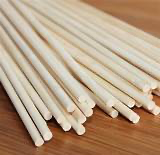
Have Brood in with pups (ensure Brood knows and is comfortable with onlookers)
Short visits initially and end on a positive before pup displays stress signals
Repeat a second time for confidence building. Pup has been there so building up more positive associations around changing environments
Use bedding that has the pups/Brood scent on it
Bring familiar toys
No new people in with pups. Staff are a familiar like toys and blankets. Limit new learning to sights, smells, sounds in new environment.
Ensure pups have been introduced to van per previous protocols.
Session 1
- Put puppies in the van – ensure you practice door manners
- Go for a short trip within the guide dogs center – less than 5 mins
Session 2
- Put puppies in the van – ensure you practice door manners 2. Go for a short trip around the center or to a close-by destination (don’t get the pups out, though!) – less than 10 mins
Session 3 Onwards
If puppies are comfortable (scoring a 4 or higher), you can start to take them to various places offsite – Maximum 25 minute drive unless approved by the litter socialisation team.
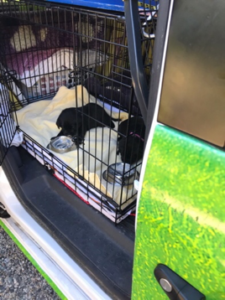
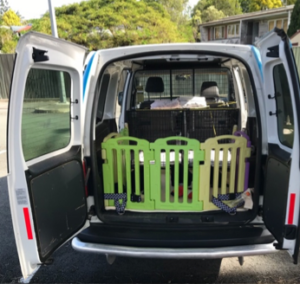
Introduce pups to the room prior to placing it in hydrobath.
No water initially. Non slip mat on floor
Pups in pairs
Familiar toys for play
Voice and touch for reassurance
Time ending so it is a short brief positive experience
Goal: To allow each puppy to explore multiple sound objects with a handler and to be comfortable with a variety of sounds.
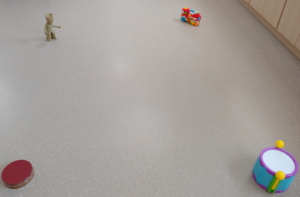
Items pictured: Dancing and singing doll, children’s toy that plays fire truck noises, tin can with pebbles inside, children’s toy drum. Use the drum sticks to make noise.
To prepare the designated space for this curriculum, please complete the following steps.
- Gather 4-5 noise objects and 2 handheld noise objects. Remember variety when selecting objects.
- Place the handheld noise objects on a nearby counter or out of the puppy’s reach.
- Arrange the objects in a circle spread apart enough for the puppy and handler to move around comfortably.
You are now ready to retrieve the first puppy you are working with.
- Allow the puppy to explore the room upon entering for up to 30 seconds.
- Use the hand-held noise objects when the puppy is playing and exploring the room.
- Encourage the puppy to explore each of the objects with you. Reward the puppy with praise, petting, and food rewards.
- Continue around the circle in the same manner.
As puppies get older, continue to use safe items that puppies haven’t seen before. You can use the items that are already in the kennel area. Items pictured: Wet floor sign, rubber boot, upright vacuum, stepstool. Be creative while keeping safety and biosecurity in mind.
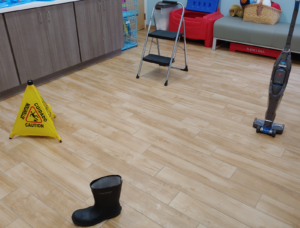
Goal: To allow the puppy to explore multiple novel objects with a handler and to be comfortable with novel objects.
To prepare your designated space for this activity, please complete the following steps.
- Gather 4-5 novel objects. Remember variety when selecting objects.
- Arrange the objects in a circle spread apart enough for the puppy and handler to move around comfortably.
You are now ready to retrieve the first puppy you are working with.
- Allow the puppy to explore the room upon entering for up to 30 seconds.
- Encourage the puppy to explore each of the objects with you. Reward the puppy with praise, petting, and food rewards.
3. Continue around the circle in the same manner.
Goal: For the puppy to confidently explore each surface with a handler.
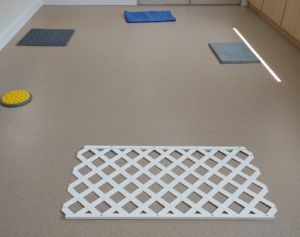 Items pictured: Plastic lattice, metal tray, plastic tarp, plastic grate, textured sensory balance pad.
Items pictured: Plastic lattice, metal tray, plastic tarp, plastic grate, textured sensory balance pad.
- Choose a variety of 4-5 surfaces. Items can be different heights, just be mindful of the puppy’s height, do not make it unsafe for the puppy.
- Arrange the items in a circle with enough distance for the puppy to walk comfortably around each item.
You are now ready to retrieve the first puppy you are working with.
- Allow the puppy to explore the room upon entering for up to 30 seconds.
- Encourage the puppy to climb on or walk over all of the surfaces. Reward the puppy with praise, petting, and food rewards.
3. Continue around the circle in the same manner.
Goal: To allow the puppy to explore multiple motion objects with a handler and to be comfortable with walking on unstable objects and moving objects.
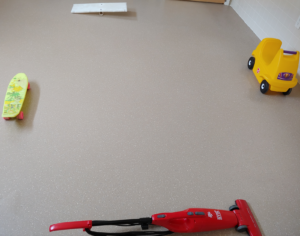
Items pictured: Vacuum, toy scooter, balance board, children’s skateboard.
To prepare the designated space for this activity, please complete the following steps.
- Gather 4-5 motion objects. Remember variety when selecting objects.
- Arrange the objects in a circle spread apart enough for the puppies and handler to move around comfortably.
You are now ready to retrieve the first puppy you are working with.
- Allow the puppies to explore the room upon entering for up to 30 seconds.
- Encourage the puppies to explore each of the objects with you. Make sure to create positive experiences for the puppy by pushing movable objects away from the puppy. Reward the puppy with praise, petting, and food rewards.
3. Continue around the circle in the same manner.
The handler can take pup outside of the den for one on one time away from the littermate. Again, a very brief experience will aid new learning and build confidence and resilience. Return pup to Brood for a comfort feed.
Only extend time away from littermates once pups are comfortable and have confidence in the handler. Pups are learning the handler will not ask pup to do more than it is capable of doing. Building trust between handler and pup is ongoing.
Goal: To establish a bond between puppy and handler and to teach puppies that following the handler is a fun and rewarding experience.
Connecting with puppy: It is important to connect with the puppy before starting any activity. This involves letting the puppy know that you are super fun and it is fun to follow you.
How to Begin Follow Me
Step 1: “Let’s Go”
Prerequisite: Connection made
- Begin in a familiar area with few distractions – a quiet hallway for example. Say “Let’s Go” and start walking forward from your pup.
- When the pup catches up with you, throw a puppy party!
- A puppy party is a prolonged period (5 or more seconds) of verbal praise, happy/excited body language by the handler, and high value rewards (given one at a time). A party is used to tell the dog, “Wow! That was awesome! You are a genius!” It’s used to emphasize breakthroughs or exceptional efforts by the dog, and to reward difficult choices (usually in distracting situations).
- Say “Let’s Go” again moving away from your pup once more.
- When pup joins you throw another puppy party.
- In the early stages of Follow Me you may be hosting frequent puppy parties, but as the pup’s understanding progresses, you will reserve parties for the next level of exceptional efforts.
Step 2: “This Way”
Prerequisite: Directional change, Connection is still solid when moving
- Find an area where you can easily change direction.
- Say, “Let’s Go” and walk forward away from your pup.
- As the pup naturally moves in your direction, say “This Way” and change direction.
- As pup follows your change in direction immediately throw a puppy party.
- Say,”Let’s Go” and move away again from your pup.
- As the pup naturally moves in your direction, say “This Way” then change direction again. As the pup follows your change in direction, immediately throw another puppy party.
Step 3: Increasing the distance and directional changes
Prerequisite: Connection remains intact with directional changes
- Stay in a familiar area when you begin increasing the distance and increasing directional changes.
- As in previous steps, say “Let’s Go” and move away from your pup increasing your distance. Remember to stop and praise the pup often for choosing to follow you.
- Be unpredictable. Don’t stop in the same spot and be sure to change direction and the number of steps you take. You want the pup to think “I really have to pay attention to the person.”
What Successful Follow Me Looks Like
- Pup starts off attentive to you and chooses to follow you without any coaxing or luring.
- You reward the pup’s voluntary decision to follow.
- Pup follows you and works to keep up with you even when you turn, change your pace and eventually in the presence of distractions.
- Pup may briefly stop and investigate something then quickly catches up with you.
Problem Solving
- If the pup stops following STOP AND SILENTLY WAIT for the pup to “rediscover” you. When the pup reconnects, praise and throw a really big “puppy party.”
- If the pup seems to have completely forgotten you, return to the pup and reconnect (Step 1) reminding the pup that you are super fun to be with.
- If connection is lost you may need to pick the pup up and move to a less distracting area and reconnect. If Pup passes you, test the connection by saying “This way!” and change your direction. If the pup follows you throw a puppy party. If the pup doesn’t follow then STOP AND SILENTLY WAIT for the pup to “rediscover” you. When the pup reconnects, praise and throw a puppy party. If pup still hasn’t responded, you will need to go back to “Making the Connection”.
- Avoid the nagging trap. Repeating the pup’s name or calling the pup to you may result in the pup tuning you out as well as diminishing the importance of the pup’s name. All you need to say is “Let’s Go” or “This Way.”
- If you are repeating the pup’s name or calling the pup to you, then you have lost the connection and you need to go back to “Making the Connection”
Key Points
- Follow Me is not only about the pup being connected. It is also about the person being connected. You need to be aware of the pup’s location and his mental state at all times.
- Developing a solid connection will help you and the pup during socialization experiences. The pup learns that wherever he goes he will understand that it is his responsibility to keep track of his partner. Short sessions + frequent practice = success: Practice in different locations inside and outside with few distractions.
- With frequent practice, your connection strengthens and the better you begin to work as a team. Establish a connection before saying, “Let’s Go” then leaving.
- Change your speed and direction saying, “This way” so pup knows you are turning, and then turn. Be unpredictable. Frequent changes in direction and speed keep the pup from anticipating your next move.
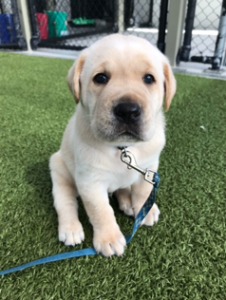
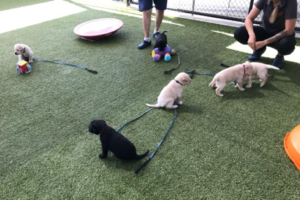
The foundation to leash walking builds off of the goals of follow me:
- Pup starts off attentive to you and chooses to follow you without any coaxing or luring.
- You reward the pup’s voluntary decision to follow.
- Pup follows you and works to keep up with you even when you turn
The only addition is a leash! To prepare for this activity, gather a leash and treat bag filled puppies’ kibble before getting a puppy to work with. SInce this is the first time the puppy has been on leash, it is important to set the puppy up for success with a distraction-free environment such as an empty room or inside of an x-pen in a safe area.
- Connect the puppy’s collar to the leash and give them a food reward
- Tell the puppy “Let’s Go” and take a few steps
- Praise the puppy for walking with you.
- Continue with the regular follow me protocol around the room twice
- Make sure to keep the session short and fun!
Troubleshooting:
If the puppy bites the leash and is having difficulty focusing on the activity:
- Call the puppy and wait for the puppy to take their mouth off of the leash. Reward the puppy with a treat. When the puppy begins to focus on you, reward the puppy again and continue.
If the puppy “puts on the breaks” and refuses to move forward:
- First, observe the puppy’s body language. Is the puppy showing any fearful or overstimulated behavior? If so, it may be best to end the session and try again later. If the puppy is displaying calm behavior, hold the leash still and tell the puppy “Let’s Go”. Wait until the puppy moves towards you and give verbal praise.
- Note: It is important to not lure the puppy with a treat in this case or the puppy will quickly learn that in order to receive a treat, they just need to put on the breaks and refuse to walk.
When to do the activity:
Bringing the puppies in from the yard
Materials needed: Treat pouch with the litter’s food
This activity assumes you have worked on “Introducing Recall” shown from week 4.
When you are ready to leave the yard, say “Puppy, Puppy” to and give each puppy a treat. Exit the yard and encourage the puppies to follow you by saying “let’s go” once. Give the puppies a treat when they come into their back kennel.
Troubleshooting:
The puppies won’t come to you or follow you out of the yard
- Decrease the distance between you and the puppies in the yard. Cue the puppy by saying “Puppy, Puppy” and treat them when they come to you.
Equipment Required:
- 3-5 different surface types – one surface should be a tray from a crate with water in it to simulate walking through puddles.
- Treats
- Space to spread out the surfaces
Protocol:
Spread out the surfaces in the play area of the run ensuring there is plenty of room between them so you can see if pup tries to avoid any
- Have pup off lead and allow them to explore in their own time for a minute or 2
- Start to encourage pup to go over different surfaces using your voice or stuffed toys.
- Praise them for going over any under-footings
- Play with them within the area to keep it fun and light
- Once pup is comfortable (equivalent of scoring a 5), the following session you can repeat with different surfaces and/or do the session at a different location.
Taking puppies for cart rides has many benefits especially for puppies that aren’t experienced with leash walking. The cart allows puppies to experience new environments passively while keeping biosecurity in mind.

Biosecurity Warning!
Make sure you consider the biosecurity needs of your puppies when trying this activity. For more information, see our Biosecurity page.
Goal: To expose puppies to new sights, sounds, smells and change of environment.
Protocol
- Allow the puppies time to relieve before placing them in the appropriate cart.
- Make sure you take a few soft toys for the puppies to play with or as back up to redirect puppies if they chew on the cart.
- Only take puppies in designated biosecure area
- Keep cart ride sessions to 10 – 15 minutes.
- Have fun! This is a fun passive experience for puppies to see new things, hear different sounds, and be comfortable in different environments. Enjoy the fresh air as you take a few puppies for a little stroll.
- Make sure to disinfect the cart after each use.
Sound Socialization Protocol:
Goal: To allow puppies to explore multiple sound objects with a handler and to be comfortable with a variety of sounds.
To prepare the designated space for this curriculum, please complete the following steps.
- Gather 5 noise objects and 2 handheld noise objects. Remember variety when selecting objects.
- Place the handheld noise objects on a nearby counter or out of puppies’ reach.
- Arrange the objects in a circle spread apart enough for the puppies and handler to move around comfortably.
You are now ready to retrieve the litter of puppies you are working with.
- Allow the puppies to explore the room upon entering for up to 30 seconds.
- Use the hand-held noise objects when the puppies are playing and exploring the room.
- Encourage the puppies to explore each of the objects with you.
4. Continue around the circle in the same manner
